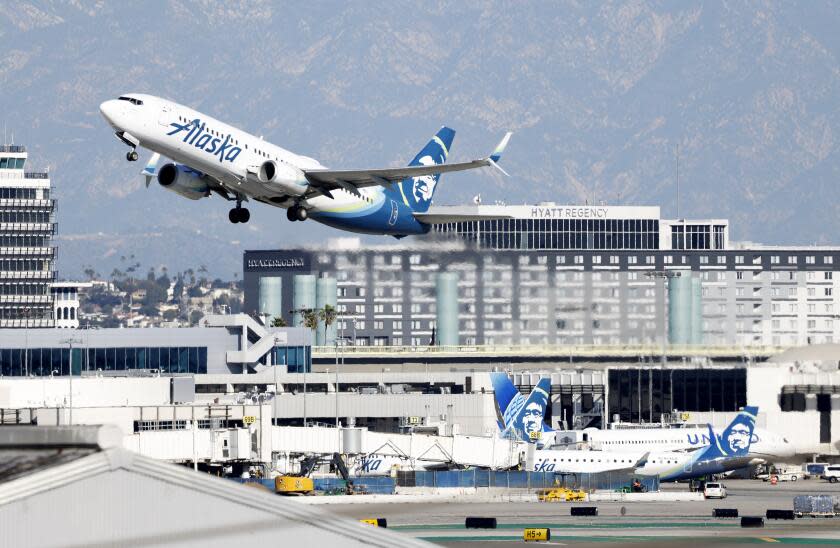Boeing CEO acknowledges 'mistake,' says midair blowout 'can never happen again'

The terrifying moment when a door plug to a Boeing 737 Max 9 suddenly blew open while the jet was 16,000 feet in the air was a "mistake" that "can never happen again," airline Chief Executive Dave Calhoun said during a company town hall.
Calhoun told employees Tuesday, "We are going to approach it with 100% transparency every step of the way" while "acknowledging our mistake."
"This stuff matters," he said. "Everything matters. Every detail matters."
But nearly a week after the alarming incident, which reportedly ripped the shirt off a teenage boy and the headrests off some seats, it remains unclear what exactly the error was — and why a hole burst open in the side of Alaska Airlines Flight 1282 as it neared cruising altitude on its scheduled journey from Portland, Ore., to Southern California.
Meanwhile, the ripple effects of the midair ordeal continue to be felt. Alaska Airlines said Wednesday it would cancel all flights scheduled aboard 737 Max 9s until at least Saturday to allow time for inspections.
Read more: Alaska Airlines cancels flights on Boeing Max 9s through Saturday
The decision is expected to affect 110 to 150 flights per day, according to the airline.
"We regret the significant disruption that has been caused for our guests by cancellations due to these aircraft being out of service," the airline said in a statement. "We hope this action provides guests with a little more certainty, and we are working around the clock to re-accommodate impacted guests on other flights."
Boeing released video of a brief portion of Calhoun's comments to employees days after the Federal Aviation Administration grounded all 737 Max 9 jets and issued an emergency airworthiness directive calling for all Max 9s with mid-cabin door plugs to be inspected before returning to the air.
It's unclear how long the planes will be out of use.
Read more: How will the Boeing 737 Max 9 problem affect air travel?
Calhoun on Tuesday complimented Alaska and other airlines, saying that although it was a difficult decision, grounding the planes "prevented, potentially, another accident or another moment."
The National Transportation Safety Board, which is investigating the incident, said Tuesday that investigators were still trying to locate four missing bolts that were meant to keep the door plug on Flight 1282 from shifting up and blowing wide open mid-flight.
The door plug in question filled in an additional emergency exit that Alaska was not using in its modified layout of the 737 Max 9.
It's unclear what role, if any, the bolts played in the incident. NTSB officials also said they were transporting the door plug to their laboratory in Washington, D.C., to determine whether the bolts were missing before the flight or if they were broken off because of the incident.
Read more: Bolts that should have kept Alaska Airlines flight's door plug in place are missing
Earlier this week, Alaska and United airlines also reported they found loose bolts on some of their 737 Max 9 jets during inspections spurred by Friday's flight, which was supposed to land in Ontario.
NTSB Chair Jennifer Homendy on Tuesday said the agency was aware of reports from other airlines about the bolts but was focused on trying to find out what happened specifically to Flight 1282.
“We need to, first and foremost, figure out what happened with this aircraft,” she said. “If we have a bigger systemwide or fleet issue, we will issue an urgent safety recommendation or push for change.”
Calhoun said Boeing was working with the NTSB in the investigation.
Read more: Alaska blowout Q&A: What’s a door plug? How does an iPhone survive a 3-mile fall?
NTSB investigators had also been looking into a warning light on Flight 1282 that had illuminated three times in the last month, indicating a possible problem with pressurization.
Alaska Airlines had restricted the plane from flying transcontinental routes, according to the NTSB.
On Tuesday, however, Homendy said the system appeared to have been working as intended, and was not the cause of the expulsion of the door plug.
This story originally appeared in Los Angeles Times.


